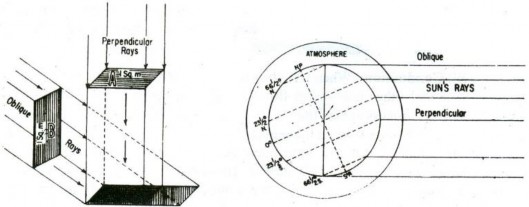1.1. Factors Influencing Insolation
The insolation received on earth is not same everywhere. The amount and the intensity of insolation vary from place to place, during a day, in a season and in a year. The factors that cause these variations in insolation are:
1. Revolution of earth around sun: earth revolves in an elliptical orbit around the sun. Thus, distance between the Sun and the earth vary. The earth is farthest from the sun on 4th July. This position of the earth is called aphelion. On 3rd January, the earth is the nearest to the sun. This position is called perihelion. Therefore, the annual insolation received by the earth at perihelion is slightly more than the amount received at aphelion. However, the effect of this variation in the solar output is masked by other factors like the distribution of land and sea and the atmospheric circulation. Hence, this variation in the insolation does not have great effect on daily weather changes on the surface of the earth.
2. The rotation of earth on its axis: earth rotates around its axis and makes an angle of 66½ with the plane of its orbit round the sun. This particular characteristic of earth has great amount of influence on the amount of insolation received at different latitudes. The seasons in each hemisphere are dictated not by the closeness to the sun but by the axial tilt of the earth.
3. The angle of inclination of the sun’s rays: Since the earth is round, the sun’s rays strike the surface at different angles at different places. The angle formed by the sun’s ray with the tangent of the earth’s circle at a point is called angle of incidence. It influences the insolation in two ways as follows:
♤ When the sun is almost overhead, the rays of the sun are vertical. The angle of incidence is large. Hence, they are concentrated in a smaller area, giving more amount of insolation at that place. If the sun’s rays are oblique, angle of incidence is small and sun’s rays have to heat up a greater area, resulting in less amount of insolation received there.

